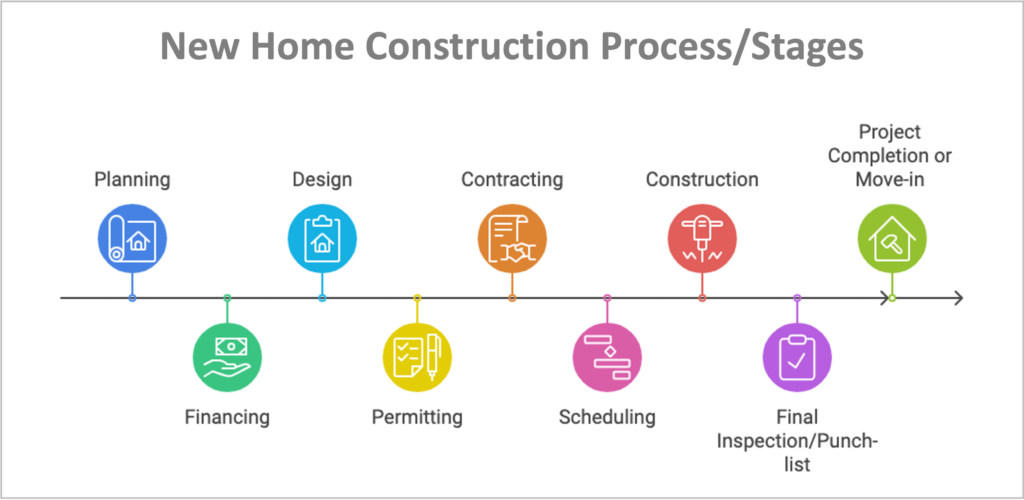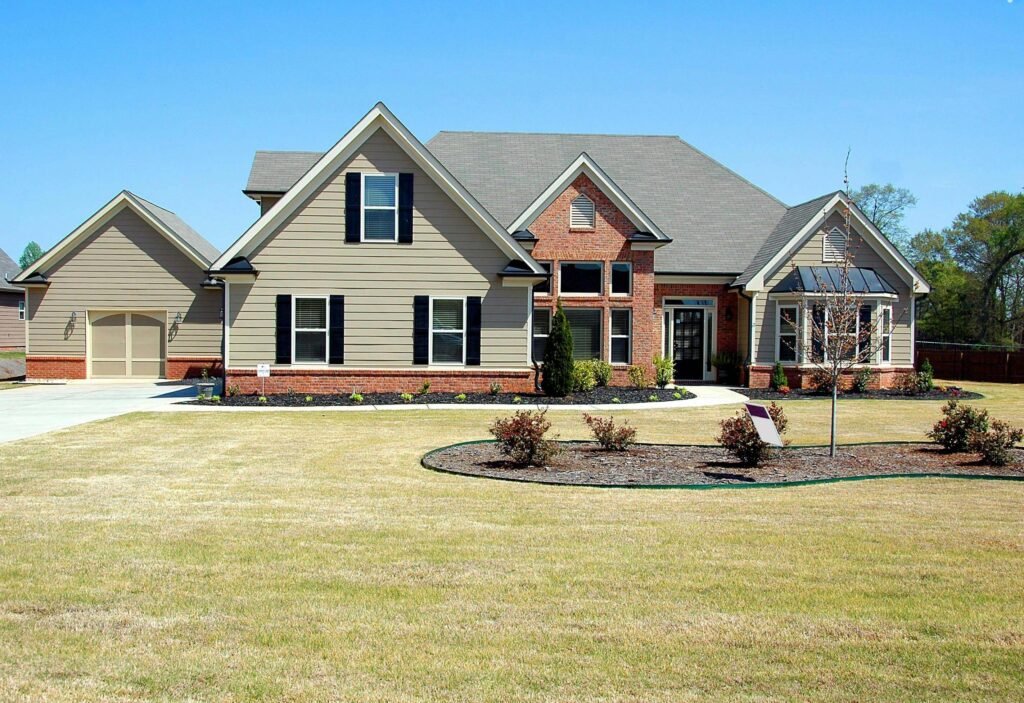Building a new home should be an exciting journey that brings your vision to life. However, many homeowners encounter challenges that turn this dream into a daunting process. Let me offer you essential free tools, resources and show you practical ways to effectively overcome the most common construction challenges, avoid numerous pitfalls and complete the construction of your new home successfully. This approach focuses on engaging professional contractors or builders, with you managing the process as the owner—not as a DIY project.
The insights, strategies and tools I share in this article are those I currently use at HomeSite Creations where we provide full turn-key home development and construction services for our clients, including strategic planning, design, financing, development, permitting and construction services, from start to finish. With over 28 years in urban planning, real estate development, and construction, I’ve helped many families overcome obstacles to complete their homes on time, on budget, and to the highest standards of quality.
Building a new home has many “moving parts” and can feel intimidating since it’s a major investment intended to enhance your family’s quality of life. While there are plenty of “horror stories” about delays, budget overruns, and quality issues, it’s also true that many families who built their own homes enjoy successful outcomes, living in homes tailored to their needs, completed on time, in excellent quality, and within budget. The negative stories tend to trickle through the internet quickly because “bad news travels fast” and tends to captivate attention quickly. But rest assured that there are countless untold success stories of families that are now reaping the numerous rewards of building their new home. The success stories come from projects that follow the principles I share with you in this article, and yours can be a success story too.
You’ll be surprised to learn how basic strategic planning, clear communication principles, and incorporating the simple tools and easy strategies that I share with you will make all the difference in solving the most common problems or avoiding the problems altogether. I’ll cover the basics for optimizing your new home construction project to help you avoid or solve potential issues.
The Benefits of Building a New Home?

Building a new home on your own land offers unique advantages over purchasing from large production builders like Pulte Homes, DR Horton, Lennar, who focus on developing communities with predefined infrastructure. Here are the main benefits and reasons why property owners decide to build on their own land:
- Cost Savings: Building on your own land can reduce costs significantly since you avoid paying for subdivision infrastructure like streets, sidewalks, and utilities, which are typically factored into the sale price by production builders.
- Custom Design: You have the freedom to create a layout tailored to your family’s needs, or modifying existing designs from floor plan to finishes, allowing for greater personalization.
- Location Flexibility: Selecting your own land gives you control over location, potentially placing your home in a setting that better aligns with your lifestyle, rather than within a specific developer’s community.
This approach offers a unique opportunity to achieve a dream home that’s truly yours, in both design and location.
Who Is This For?
Anyone considering or already building a new home on their own land or on a property they plan to purchase will benefit from understanding the process, challenges, and strategies for making smart decisions. Whether you’re just beginning, looking into the possibility, or already in the development or construction process, this article offers insights to guide you toward a successful project.
I must mention that the new home construction path isn’t for everyone. Challenges are inevitable, as with any worthwhile endeavor, and it requires commitment, time, and effort. However, if you’ve made the decision to build your new home, it can be a great success and you are able to navigate risks and achieve great results by making wise decisions and incorporating proven tools and strategies, just as countless others have. This article is designed to help you maximize the process, avoid common pitfalls, and set you up for the successful planning, development and construction of your new home.
Quick Overview of Your Project

Whether building a single-family home, a bridge or a skyscraper, all construction projects follow a similar process or stages of development: Planning, financing, design, permitting, contracting, scheduling, construction, final inspection/punch-list, and project completion or occupancy. While the order of these stages and the complexity will differ by project type and scope, these are the basic steps for every construction project, including yours. Accomplishing each stage cost-effectively, timely and with optimal quality will determine the level of success of your project.
Recommended Construction Method

Before diving into the core of this article, I want to highlight a key strategy that I use in my residential and commercial projects to ensure quality, efficiency, and cost-effectiveness: Advanced modular construction. Unlike outdated prefab methods, today’s modular technology allows for the creation of beautiful high-quality homes that are indistinguishable from conventionally built homes inside and out, and superior in durability. Modular homes can be customized to meet your exact specifications and provide distinct advantages over conventional “stick-built” homes, including faster build times, superior quality, higher efficiency ratings, and reduced costs.
While modular construction isn’t available everywhere, it’s worth considering if there’s a reputable modular builder in your area. For instance, at HomeSite Creations, we serve NW Pennsylvania, East Ohio, and select cities in New York. Thanks to our modular approach, clients move into high-quality, efficient homes within 3-6 months, with the added security of a 10-year warranty. To learn more about the benefits of modern modular construction, feel free to download or view my recent book, Modular Homes: The Smart Choice for Homebuyers.
Start With a Basic Spreadsheet

Financial issues are among the most common challenges property owners face when building a new home, often resulting from budgeting, forecasting, and financial management mistakes. Poor financial oversight can derail a project entirely, but with proper planning and a few straightforward financial management strategies, you can avoid these pitfalls and stay on track.
The first step I always recommend is preparing an initial budget and listing all development items in a pro forma spreadsheet. Regularly update this pro forma throughout the project, checking it daily against actual proposals, invoices, and receipts. This document will be crucial for loan applications, contractor negotiations, budgeting, and overall project management, helping you maintain financial control and prevent unexpected costs from threatening your dream home.
Free Tool: Looking for a template to kickstart your project? I’m pleased to offer my single-family home development pro forma spreadsheet, complete with user-friendly instructions for any new construction project—absolutely free. This template is designed to help you analyze, estimate, and finance your project with ease. View/Download My Free Pro forma Spreadsheet Template Here.
Engaging The Right Contractors

While setting up and managing the financial items of your project is critical, the success of your project also depends largely on the contractor(s) that you engage. If you haven’t heard “horror stories” of homeowners that hired the wrong contractor resulting in chaos, simply google “new home construction horror stories”. Following are the most common problems I found when I performed that research:
- Frequent delays in project completion
- Project costs exceeding the agreed budget
- Unreasonable and unfair change orders
- Builder refuses to address important issues
- Contractor lacks reliability and responsiveness
- Builder fails to deliver as specified
- Dissatisfaction with the quality of workmanship
The most effective way to avoid the above contractor-related problems is by strategically engaging experienced contractors that work cost-effectively and in good faith to complete your project on time, on budget, with high quality, and as agreed per the contract. One of the reasons I strongly recommend using modular construction is that it minimizes on-site work, therefore contractor mishaps, delays and cost-overruns are significantly minimized with this approach.
Whether your home is being built with modular technology or conventionally, how do you select the right contractor to avoid the above pitfalls? While this article is not intended to be a comprehensive “how-to” guide, I offer the following key strategies that I use when engaging new contractors in any situation. These strategies have enabled me to engage superior contractors that perform excellent quality work, while avoiding questionable builders and the associated potential pitfalls:
Tips for Choosing and Working with Quality Contractors
- Do Thorough Background Research: Request a list of completed projects, years of experience, copy of license, and a list of recent clients with their contact information from the potential contractors, and examine their reputations by reading reviews, verifying their qualifications, and speaking with former clients about their experiences.
- Compare Estimates: Request at least three estimates from various contractors to evaluate their pricing and offerings, helping you spot any issues early on. You can take this a step further and research standard pricing for new homes similar to your within your specific area, or nearby.
- Carefully Review Contracts: Go over all contract details closely, ensuring that it includes specific information about the project scope, payment terms, and timeline. It’s advised to have a good attorney assist you with this step. The cost of a contract review and advice can be worth its weight in gold.
- Follow Your Gut Feeling: If a contractor seems untrustworthy or pressures you into a quick decision, don’t hesitate to consider other options.
Incorporating the above principles can help you find a trustworthy contractor and ensure a smoother construction process while avoiding some of the most common problems in new home construction projects. This is critical to your project’s success. I strongly caution every homeowner not to proceed with a new home construction project until achieving a high degree of certainty about the capacity, capability and genuine commitment of the contractor(s) you plan to engage.
Managing Budget Overruns and Unexpected Costs

Unexpected budget overruns can happen to the best managers for a variety of reasons outside of their control, including supply shortages, economic downturns, weather conditions, and numerous other factors. I haven’t met a manager yet that has not faced this problem in construction. The key is preparing in advance to strategically manage the situation ensuring the success of the project and the most favorable outcome despite potential setbacks. I always emphasize the importance of creating a realistic budget, complete with a 5-10% contingency fund (depending on the size and scope of the project) as a reserve for unexpected costs that may occur.
Successful budget management requires more than adding arbitrary percentages. Detailed research and precise cost calculations for each project line item is needed to navigate these challenges effectively.
Ensure your contractor’s proposal provides a detailed breakdown of all major items involved in your home’s construction. Research each item to confirm the pricing aligns with your budget and industry standards. This diligence will empower you with knowledge, allowing you to negotiate effectively and potentially uncover cost- and time-saving opportunities.
Contractor change orders and cost increases are common issues in home construction. These can be minimized through proactive management and open communication with your contractor to address potential “unforeseen events” and avoid unjustified change orders. Justifiable change orders include events like natural disasters causing damage during construction, or your own decision to upgrade items. However, if delays or material damage occur due to contractor negligence, these should not justify cost increases. To avoid surprises, clearly outline terms for change orders and potential cost increases in your contract from the start.
Pro Tip: Purchase materials, fixtures, and finishes directly, if possible. This approach helps avoid price inflation on materials and limits the contractor’s ability to add unnecessary change orders. Many lenders allow homeowners to buy materials through their construction loans. By handling material purchases yourself, you gain control over costs and reduce the chance of hidden markups, helping you save time and money.
Create a Realistic Budget with Contingencies

It’s always a smart move to set aside 5-10% of your total project budget as a contingency fund. This money serves as a financial safety net that shields your project from surprises along the way. Our experience at Metrovitalization reveals common hidden costs that often catch people off guard:
- Building permit fees can be significant in certain locations
- Required insurance and liability coverage
- Costs of utility connections and temporary power
- Expenses for waste management
- Site cleanup after construction
List all project costs in your pro forma spreadsheet, covering both soft costs (like architectural and engineering fees, permits, insurance, property taxes during construction, financing, closing fees, municipal inspection fees, surveys, and appraisals) and hard construction costs. Ensure these total costs, including contingency, fit within your loan amount.
Monitor expenses closely during construction and seek cost-saving opportunities through value engineering with your contractor. Value engineering involves optimizing design, materials, and supplies to reduce costs as the project progresses, helping you keep changes favorable to your budget.
Pro Tip: For project financing purposes (your home construction loan), the costs of your project should be categorized as the “Uses of Funds” in your project pro forma, and the project loan plus any cash and/or equity you invest must be categorized as the “Sources of Funds”. Prior to financing the project, the project lender will typically require a review of your project pro forma or budget demonstrating that the Uses of Funds and Sources of Funds are equal. This demonstrates to the lender that your project is in balance, which is usually a requirement for underwriting your loan by the bank.
My free pro forma spreadsheet template provides this format, so you can use it for the purpose of financing your project.
Working Closely with Builders on Budget-Friendly Solutions

I recently learned of a homeowner who encountered challenges with her custom home build. Partway through construction, she received an unexpected invoice for a change order that significantly increased her budget, and she did not have availability of funds in her construction loan. The contractor cited “unforeseen adjustments,” but it quickly became clear that the lack of well-defined terms around change orders in the contract left her vulnerable to these added costs. This situation highlights the importance of setting clear expectations and communicating with contractors from the outset. It’s a reminder that proactive planning and contractual clarity can prevent these kinds of budget surprises and ensure smoother project outcomes.
To avoid unnecessary expenses, delays and other related complications, clearly identify acceptable parameters for change orders and cost increases within your contract, and only approve change orders that are clearly justified in line with the contract. Reinforcing this with your contractor throughout the project helps set expectations and reduces the chance of unwarranted cost increases.
Regular budget reviews and meticulous expense tracking are essential for effective cost management, allowing you to detect potential issues early and address them before they escalate. Maintaining detailed records of all expenses and changes is crucial to staying within budget and avoiding unexpected overruns.
In my professional practice, I collaborate closely with builders to implement value engineering strategies that prioritize cost efficiency. Opting for stock designs, for example, can significantly reduce expenses compared to custom plans. Additionally, we emphasize open communication with the project team to manage and discuss potential changes in advance. This proactive approach helps ensure that any necessary adjustments align with the budget and minimizes the risk of overruns due to unforeseen change orders. By working together on budget-friendly solutions, we create a smoother construction process that achieves quality results within financial constraints.
Dealing with Construction Delays and Timeline Issues
Effective time management is essential in home construction, and overcoming delays requires a solid communication strategy. Our approach to managing timelines includes:
- Regular updates in scheduled meetings
- Clear records of timeline adjustments
- Quick ways to report issues
- Specific contacts assigned to each project area
- A project tracking system with regular updates by email, text or other online form
We also keep comprehensive records of all communications and timeline adjustments. Setting realistic expectations based on the project’s complexity and available resources has proven to build trust with clients. This proactive, transparent approach helps prevent frustration, enhances client confidence, and fosters stronger working relationships.
By incorporating this approach as a homeowner building a new home, it can enable you to address potential delays early, set clear expectations, and resolve timeline issues before they become major obstacles, ensuring the project stays on track and within budget.
Preparing for Weather-Related and Permit Delays

Severe weather is a common source of construction delays in many areas, impacting both site accessibility and overall work progress. Rain, snow, extreme temperatures, and other adverse conditions can stall operations, sometimes for days or weeks at a time. To mitigate these potential setbacks, our team builds in a “cushion time” specifically for weather-related delays. Additionally, we adopt proactive measures, such as increasing work hours or adding additional crews during favorable weather, to keep projects on track. By adjusting our work schedules dynamically, we effectively reduce the impact of unavoidable weather disruptions.
Permit and administrative delays present another significant challenge in construction timelines. Regulatory approvals and permits often require substantial processing time, and any unexpected issues or backlogs can push timelines out even further. To avoid these bottlenecks, we initiate permit applications early in the planning phase, allowing room for any unforeseen administrative holdups. Close collaboration with local authorities and regular follow-ups also help ensure that applications move through the system without unnecessary delays.
Approaching each project with strategies to address both weather and permit-related delays has proven essential in maintaining our timelines and delivering quality work on schedule. By anticipating the above challenges, incorporating the principles and implementing these proactive measures, homeowners can help ensure project completion dates with more confidence, while safeguarding processes against these common construction setbacks.
Addressing Quality Control and Workmanship Problems
Quality control is the cornerstone of successful home construction. In my experience, catching workmanship issues early not only prevents costly repairs but also saves valuable project time.
Our four-phase inspection system is designed to ensure high standards at every stage of the build:
- Pre-foundation inspection – A thorough review before pouring concrete to confirm site readiness and adherence to specifications.
- Post-framing inspection – Detailed checks after framing, including plumbing and electrical installations, to address any structural or safety concerns.
- Ongoing inspections during finishing – Continuous oversight of all interior and exterior finish materials and installations to ensure top-quality finishes and adherence to design.
- Final comprehensive inspection – A meticulous assessment before project completion to confirm that all work meets our quality standards.
Conducting regular inspections throughout construction reduces the risk of errors, delays, and unexpected change orders. Maintaining an active presence on-site communicates to contractors that quality is a priority, encouraging them to uphold high standards. We document each inspection with detailed photos and reports, which we share with our contractors for transparency and accountability. This rigorous approach strengthens collaboration, enhances workmanship, and ensures the best outcomes for your new home.
Having a process for addressing defects and errors
When issues arise, our team follows a structured, proactive approach to resolve them efficiently. As soon as our quality control team identifies a defect, they conduct a thorough inspection of the affected area, assessing the scope and nature of the problem. Through experience, we’ve learned that addressing issues early prevents minor defects from escalating into costly, time-consuming repairs.
We have implemented a robust daily reporting system to log and monitor any issues, which enables us to catch potential defects quickly and track their resolution progress. I encourage homeowners to adopt a similar process for their construction projects. A consistent reporting system fosters accountability, ensures quality, and helps prevent minor issues from becoming major setbacks, ultimately leading to a smoother, more reliable building experience.
Conclusion

Building a successful home requires a focused approach to budget management, timeline planning, quality control, and supply chain management. Key strategies such as thorough contractor vetting, proactive backup planning, and early procurement of materials can help sidestep common construction setbacks. Together, these measures—paired with meticulous documentation and regular inspections—create a solid framework that safeguards homeowners from costly delays and overruns.
Guidance from experienced professionals can make a significant difference in overcoming construction challenges. Addressing issues early in the process conserves both time and money. Budget constraints, scheduling pressures, and supply shortages are inevitable, but having expert support can help navigate these obstacles smoothly.
If you’re looking to build a new home in Northwest Pennsylvania, East Ohio, Northwest New York State, or nearby areas, visit us at HomeSite Creations. Select a plan, complete our HomeBuyer Journey Form, and let us take care of the rest. Our program manages every step cost-effectively—from planning and financing to design, permitting and construction—so you can move into your dream home in just 3-6 months. We look forward to turning your vision into reality!
I hope this article guides you toward a successful home construction experience. Subscribe to Metrovitalization for more insightful content like this.
About

Ricky Trinidad is an Official Member of the Forbes Business Council and the Modular Home Builders Association, President of HomeSite Creations, and President of Metrovitalization, an urban planning, development, and construction company in Pennsylvania that specializes in sustainable and community-conscious real estate development, focusing on revitalizing areas physically, economically, aesthetically, spiritually, and environmentally with a unique approach that integrates high-quality construction with a commitment to community enhancement.
Hashtags
#HomeSiteCreations #HomeConstruction #BuildingDreamHomes #NewHomeBuild #ConstructionTips #HomeBuilding #RealEstateDevelopment #ConstructionPlanning #QualityControl #ProjectManagement #BuildingOnYourLand #Metrovitalization #CustomHome #HomeDesign #ProformaTemplate #HomeBuilder #NewHomesInPennsylvania #ResidentialLiving #ModernLiving #SustainableLiving #RickyTrinidad #ForbesBusinessCouncil #CommunityGrowth #Homeownership



